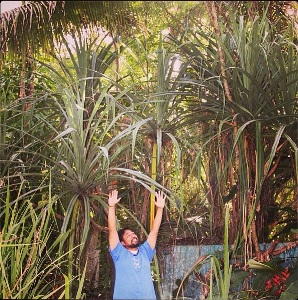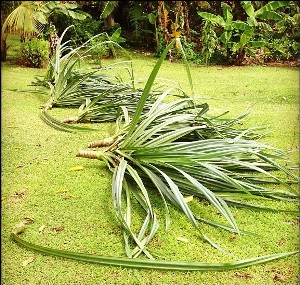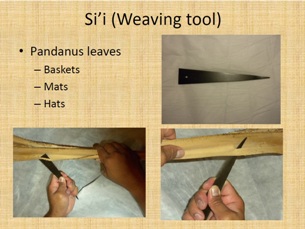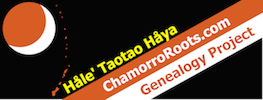On November 27 2013, I wrote about the "Data on Chamorro Weavers ." That article primarily served as my initial observation of data contained in the 1920, 1930 and 1940 Census, and in the event anyone or even I would have a future interest in researching more about this component of our history and heritage.
Recently, I came across a 1937 article, "Akgak Weaving," from the Guam Recorder that was written by Ana P. Torres. It provided me with a little more insight about the åkgak and additional information for that particular period and so I made a copy of that 1937 article to share with everyone.
Tronkon Åkgak / Åkgak Tree
If you’re like me, I wondered what the åkgak tree look like. Below is a picture of James Bamba and åkgak that he posted on flickr. According to James, the “Tronkon åkgak, or Pandanus tectorius, the local pandanus cultivar planted on Guam for weaving. Propagated by cuttings as the plant isn't reported to fruit or flower. These trees are almost three times as tall as I am.” In the second picture, he was staging these cut stems of åkgak for replanting. I think it’s really cool with what he was doing with these and the many other Chamorro art products he produces every now and then.


According to Ms. Torres article, it is believed that the åkgak may have come from India many centuries ago, where it is primarily cultivated. Among the many weaved uses of the åkgak:
“The dried leaves, when picked and stripped of their rigid spiny keel, are used either in this form or twisted together to lash or secure the framework of houses and thatched roofs.
For weaving mats and large bags, the dried leaves are picked, the spines stripped off and each leaf is rolled and kept in this state for a period of three days. The purpose of the roll is to stretch the leaf.”
“…For weaving small bags, baskets, mats, cigarette cases and other fine work, the young green leaves are picked, steeped in boiling water for two minutes, scraped of their spines, and dried in the sun.”
Si’i (Weaving Tool)
The article also mentions the “si’i,” which is a weaving tool. I found this next picture of the si’i from Peter Toves’ “Chamorro Traditional Tools,” presentation.

Maria L. Mesa & the Weaving Club of Merizo
It was also interesting to note that Mrs. Maria L. Mesa of Merizo was a catalyst for inspiring people with the benefits of derived from manufacturing weaved åkgak products. She even organized a weaving club in Merizo in hope of others villages and people would follow suit.
Guam Åkgak Shop
Also in 1937, there was a sufficient amount of manufacturing weaved products to open the Guam Åkgak Shop at the Island Market Building. The Shop was open from 3:00pm to 5:00pm and on each Saturday from morning to noon. “A large assortment of luncheon sets, coasters, cigarette cases, bridge sets, purses and baskets of all descriptions are available.”
Does anyone recall or know exactly where the Island Market Building was located?
Today’s Weaving Opportunities
I would be curious to know what weaving efforts exist today in our islands that contribute to the economy. Although a lot of effort and labor is involved, weaving does remain an economic opportunity for those willing to make a go of it.
I would imagine many tourists would be willing to purchase weaved products as their authentic souvenirs and memoirs of our islands and culture.
I would also imagine that these products would be priceless for those of us abroad and to proudly display a part of our heritage.
Hafa mahon? Hafa hinasson-mu? What do you think?

